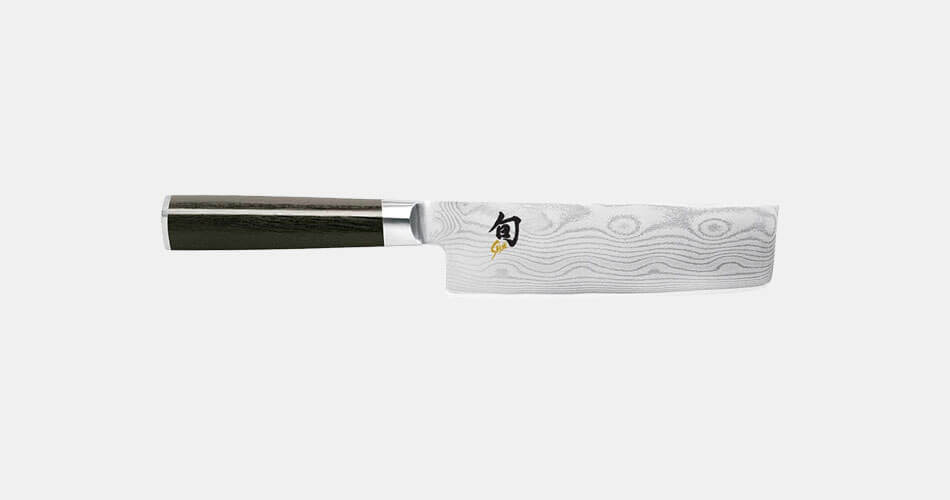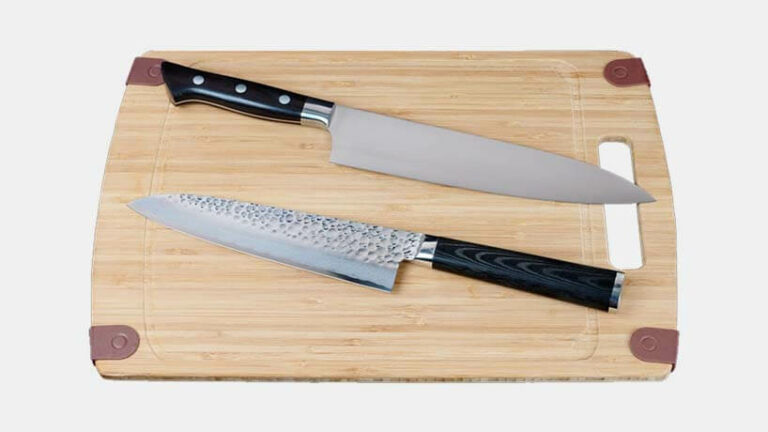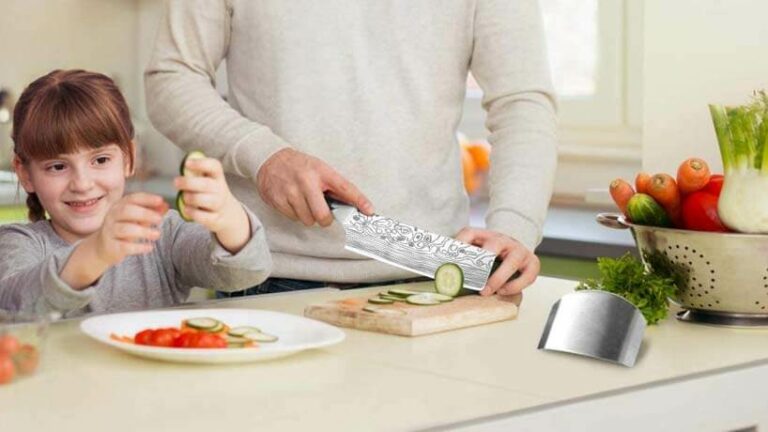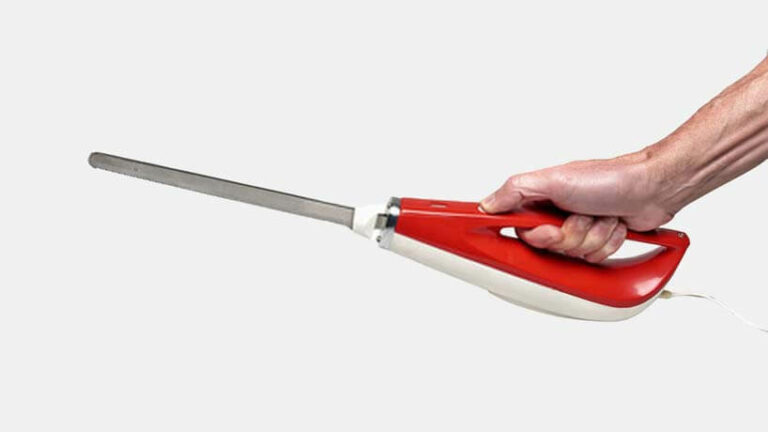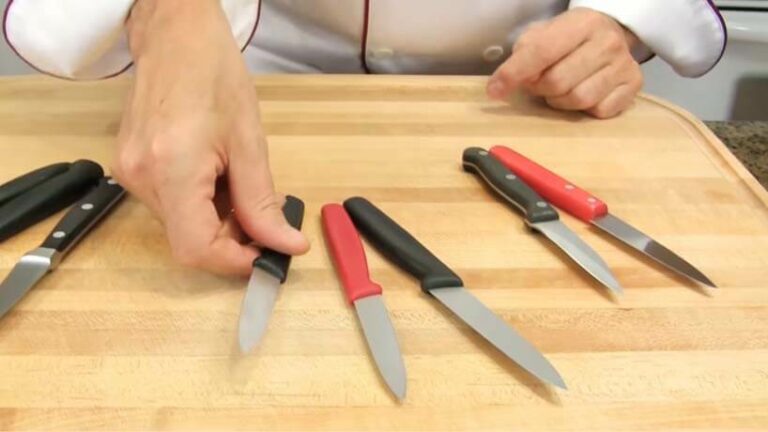Japanese knives are revered for their excellence and consistency in the kitchen. Crafted with centuries of experience behind them, you’ll find stunning and alluring knives for almost any needs or styles. With that said, it’s easy to get bogged down with all the choices you have. In this guide, we’re going to show you what to look for in the best nakiri knife – and help you choose the perfect knife for your style and needs. Our goal is to get the right knife into your hands, get value for your money, and become more versatile in the kitchen. Let’s get started!
Top 7 Best Nakiri Knife Reviews in 2023
We’ve carefully selected 7 nakiri knives we think cover a versatile set of needs, budgets, styles, and more. You’ll find some excellent budget options and some mind-blowing premium class-leading choices. By the end of our guide, you’ll know what kind of value to expect at different price points, and which type of knife is perfect for you.
Remember to keep your needs close in mind. A nakiri knives that are perfect for me might be atrocious for you. If you want to make the best possible choice, write down everything you’re looking for (either now or as we make our way through the guide). Let’s dive into our top-rated nakiri knife reviews!
Mercer Culinary Millennia Nakiri Knife
Mercer is quite widely known for producing fantastic quality budget knife ranges. Maybe you’re just getting started, or you’re looking to get something more reliable without having to pay a hefty price tag. Value for money is a given here. The balance between cost-saving measures and no unnecessary compromises brings you a knife you can trust.
The ergonomic Santoprene handle is fantastic for learning on. You’ll enjoy the slightly raised spine for building a quick chopping technique. It’s slip-resistant and textured to give you fine-tuned control over the blade. Despite the low price, this knife uses pretty high-quality steel.
The high-carbon content gives you better edge retention and sharpness, as well as decent protection against rusting and corrosion. These blades are a little on the brittle side, so make sure you hand wash them and don’t use them for anything but fruits and vegetables. It comes wicked sharp out the box and ready to go.
The minimalistic design looks fantastic and you won’t have trouble caring and maintaining its appearance. Overall, this is one of the best nakiri knife options in this price range. You’re getting big value for money and an excellent knife to hone your chopping skills with.
- Ergonomic and non-slip handle
- Lightweight and easy to use
- Decent edge retention and a razor-sharp edge
- Easy to clean and maintain
- Doesn’t comes with a sheath of protective case
- Finger guard is a little under-sized
TUO Nakiri Vegetable Cleaver Knife
Using the same high-grade 50CR15 steel, this knife performs excellently in the kitchen. It’s resistant to rusting and corrosion and holds a wicked cutting edge. You get a full-tang build and a gorgeous Pakkawood handle. It’s ergonomic, robust, and comfortable – which is a surprise considering how affordable the knife is.
The handle has been designed to not shrink, expand, chip, splinter, or take moisture damage. All this comes together to bring you a durable and reliable knife that’s hygienic. You’re getting fantastic value for money and impressive performance. You also get a protective case for the knife. This is quite a unique add-on in this price range and goes a long way to extend the knife’s lifespan.
The tall blade gives you plenty of weight to work with. It’s versatile enough to be a sole-driver for vegetables, herbs, and fruits. You’ll find it to be capable and user-friendly. Overall, it’s probably the best budget nakiri knife with a Pakkawood handle and a cutting edge as impressive as this!
- Capable and versatile
- Moisture-resistant hygienic Pakkawood handle
- Slightly taller blade
- Gorgeous design and appeal
- Quite heavy compared to similarly priced knives with a Santoprene handle
- Doesn’t come as sharp as it could out the box
Shun Cutlery Classic Nakiri Knife
Shun arguably makes some of the highest-quality nakiri knives on the market – and this is no exception. It’s been elegantly hand-crafted and can easily fit into a professional setting or high-performing kitchen. The 6.5” blade is made from 68-layer VG-MAX steel. It’s extremely durable and robust.
You’ll get an ultra-sharp edge that won’t dull quickly either. Chopping and cutting are swift and clean. You’ll make quick and accurate work of vegetables, herbs, and fruits. You can get super-thin slices and the edge breezes through the cuts without crushing or bruising.
Despite not having a hammered blade, it’s surprisingly good at keeping the food from sticking to its side. This knife will handle light daily use just as well as intense professional use. It’s exceptionally good at slicing tomatoes. An ergonomic Pakkawood handle helps to balance the weight of the blade.
It gives you fine-tuned control over the blade, making chopping effortless and quick. This best nakiri knife costs a pretty penny, but it’s worth every one. You’re getting a capable and versatile professional-grade nakiri for your kitchen.
- Razor-sharp cutting edge with excellent retention
- Stunning Damascus-style finish on the blade
- Solid and robust ergonomic D-shaped handle
- Perfectly balanced
- Quite expensive
- Not suited to left-hand use
Dalstrong Shogun Series X Nakiri Knife
Here’s the first truly high-end premium best nakiri knife. At 6” long, the blade is capable and versatile. You can work on all vegetable, fruit, and herb related meal prep. The premium build quality and material choice give this knife robustness that’s not common to many nakiri knives. The sides of the blade are hand-polished and beveled at 8-12°.
This gives you an awesome cutting edge that won’t bruise or crush your vegetables. You immediately notice the hammered finish of the blade. Other than giving the knife an intimidating and premium look, it’s perfect for stopping food slices from sticking to the blade’s side. You can cut exquisitely thin slices and not worry about them breaking on ruining the next slice’s accuracy.
The AUS-10V Japanese steel is extremely durable and resistant. It doesn’t show scratches easily and care and maintenance are simple. You’ll find the cutting edge comes extremely sharp and hold for a long time without needing to be touched up. We love the G10 handle. Its military-grade construction is class-leading, ergonomic, and robust.
It’s the perfect addition this knife needs to offer you a complete package. You have to pay a pretty penny for this knife, though it’s quite fairly priced considering its premium design and top-class performance. Overall, this is the best quality nakiri knife if you want premium performance at an attainable price.
- Hammered finish stops food sticking to the blade
- G10 handle is excellent
- High-quality steel with class-leading corrosion resistance
- Very well-balanced
- Not very beginner-friendly
- Quite heavy for a nakiri knife and takes some getting used to
Shun Premier Nakiri Knife
Our last knife in this review is a classy and classic Shun knife. Widely known as one of the best nakiri knives in this price range, you get a slightly shorter blade. Despite the smaller frame, this knife doesn’t make any sacrifices when it comes to efficiency. It’s incredibly versatile and easy to control – a perfect option for quick dicing and chopping in a bust kitchen.
The lightweight body is well-balanced and has just enough heft to be functional. You’ll find it handles light and delicate work just as easily as more demanding work common to professional kitchens. It’s a gorgeous knife and the hammered finish adds to its appeal. Food doesn’t stick to the sides of the blade, making it extremely efficient and accurate.
If you’re looking to build up your skills, this is an enabling knife that will take you a long way. The premium Pakkawood handle is durable and robust while still being comfortable to work with. It suits different grip styles and hand sizes, as well as adapting to left-hand use. We love Damascus steel and this knife makes excellent use of it.
The combination of the hand-hammered finish and the resistant steel brings you a long-lasting and top-performing knife. If it fits your budget, this knife is a stable and capable choice for any kitchen. It has exceptional handling and a slightly lighter build, making it fantastic for beginners and getting professional-grade results.
- Stunning hand-hammered finish
- Durable Damascus steel knife
- Excellent quality and well-designed Pakkawood handle
- Very well-balanced and suited to fast chopping
- Blade is quite short compared to other similarly priced nakiri knives
- Quite hard to clean and maintain thanks to the hammered finish
Mercer Culinary Genesis Forged Nakiri Knife
You get a decent Santoprene handle that’s shaped to be ergonomic and textured to be non-slip. It’s easy to hold and simple to work with – especially for more demanding chopping and prep work. While it’s a little more expensive than the Mercer knife above, you get a more durable and robust build.
The bolster gives you a seamless transition to the blade and makes handling the knife even easier – plus it’s sleek and attractive. 50CR15 high-carbon steel provides the corrosion resistance and edge retention you need on a nakiri knife. While it’s quite lightweight, there’s just enough heft to let you work on your chopping speed and technique.
The edge is taper-ground for more stability and an impeccable cutting edge. You don’t need to worry about bruising or crushing whatever you’re chopping. Perhaps our favorite feature is the full tang. This is what makes it worth the extra money. It greatly extends the lifespan of the knife and gives it a tasteful heft.
Chopping and cutting feel effortless. Overall, this is one of our top picks for the best nakiri knife for the money. It’s efficient and effective, looks sleek, and handles like a far more expensive knife.
- Ergonomic, full-tang handle
- Taper-ground edge can get ultra-sharp
- Easy to clean and maintain
- Comes sharpened and ready to go
- Cutting edge is a little fragile (brittle)
- Not too well-balanced as the handle is quite a bit heavier than the blade
Wusthof Classic Hollow-Edge Nakiri Knife
Wusthof makes excellent premium knives and you get what you pay for here. While they’re not cheap by any means, if you’re a serious enthusiast and you’re looking to take your kitchen to the next level, you won’t go wrong here. Wusthof knife features a slightly taller blade and dimples along its side to stop food from sticking to it. It cuts exceptionally well and chops efficiently.
There’s just enough weight to maximize your work speed without holding you back. This, combined with the high-quality, triple-riveted handle makes the knife a pleasure to work with. Edge retention is astounding and the fine 10° cutting edge can be honed to razor-sharpness. You’re getting all the resistance and durability you’d expect from high-carbon stainless steel.
It has raw durability and a pleasant minimalistic finish. This is a knife that would slot well into both a home and a professional kitchen without much trouble. Overall, you’re getting more than you pay for with this best nakiri knife. It has the potential to last for years without a major drop-off in performance or quality.
- Extremely sharp 10° cutting edge with good retention
- Highly durable high-carbon stainless steel
- Fantastic triple-riveted ergonomic handle
- Minimalistic and classy finish
- Expensive
- Not great for beginners
How to Best Choose a Nakiri Knife
Who doesn’t love a great deal? – excellent quality for cheap – it can be an absolute pleasure to find such a treasure box. The only problem is that it rarely works out that way. Usually, if something is cheap, it’s of a lower quality, and if it’s expensive, then it’ll probably be higher quality (sometimes even that doesn’t work out). So where’s that perfect balance? Let’s take a look at some insight into how to choose the best thing for you.
Edge Retention
One of the most frustrating things is getting home to prepare a meal after work is to pull out your knife and start cutting only to find yourself exhausted 5 minutes in. The edge of a blade is where the magic happens. If you take care of it, it’ll take of you. A knife that uses high-end steel will typically be a rockstar at staying sharp.
Japanese steel, like VG-10 or AUS-8, is well known for how long it stays sharp, and on top of that, simply how sharp they are in the first place. German high carbon steel is also a wonder worker in the kitchen. It retains its edge well and provides good durability.
Handle and Grip
It’s crucial to be comfortable when slicing and dicing. An ergonomic handle will offer you the greatest satisfaction when carrying out tasks in the kitchen. A strong handle material like carbon fiber, stainless steel, or wood is a good pick, and if you opt for any of these, you won’t be let down. Just be sure to get a knife with a full tang and thumb grooves at the beginning of the blade.
Frequently Asked Questions (FAQ)
Q: Is a Nakiri Knife the Same as a Shun Knife?
A: A shun knife is used for a similar purpose as a Nakiri knife, but unlike a shun knife, a Nakiri blade is only supposed to be used to cut vegetables. Shun knives can be used to cut meat (without bones) and fish etc.
Q: Why Are Nakiri Knives So Thin?
A: They are designed that way to make thin-slicing a breeze in comparison to thicker chef’s knives, which can be challenging to cut fine slices with. Simultaneously, the vegetable slices often stick to the blade making the workbench messy; but with Nakiri blades, the vegetables peel off with ease.
Q: Are Nakiri Knives Rust-Resistant?
A: Most of them are. If the type of steel used is stainless, then it will, by all means, be resistant to rust. If the blade is made out of carbon steel, it is likely to be less resistant to rust. However, if the carbon steel is mixed with chromium or zinc, it will be very rust-resistant.
Stainless steel blades can be put in a dishwasher, but be aware that carbon steel blades should not, so you should wash them by hand and dry them immediately.
Final Thoughts
You should have a clear idea of what you’re looking for in a nakiri knife. Remember to take note of your most important needs and to balance that with the price. All that’s left is for you to make your choice. We’ve given you choices that suit different budgets, styles, and needs.
Getting the best nakiri knife is much easier once you know what you’re looking for. Take what you’ve learned here and put your new knowledge to good use – good luck!




